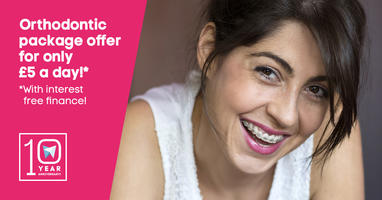Many orthodontists say kids should see an orthodontist once their permanent teeth start coming in, around age 7. At this age, issues such as uneven bite and overcrowding will become apparent. Starting the process early doesn't mean a child will get braces right away. After consulting our Forest & Ray orthodontist, the actual placing of the braces is straightforward.

We explain the process, what you should do before and after and what to expect in follow-up appointments. For most patients, getting braces put on takes about 1-2 hours. The process may seem a little unpleasant, but you shouldn't worry about pain. First, our dentist will clean and dry your teeth; then he or she will apply a special glue that holds the brackets on.
What are my options?
Today's orthodontics offer more kinds of braces than ever before. Check out your options:
Metal braces/Traditional braces
These are the metal brackets and wires that most people picture when they hear the word "braces." However, modern brackets are smaller and less noticeable than the notorious "metal-mouth" braces that many adults remember. Plus, new heat-activated archwires use your body heat to help teeth move more quickly and less painfully than in the past.
Ceramic Braces
Ceramic braces are the same size and shape as metal braces, except that they have tooth-coloured or clear brackets that blend into teeth. Some even use tooth-coloured wires to be even less noticeable.
Pros: Less noticeable than metal braces; move teeth much faster than clear plastic aligners (Invisalign)
Cons: More expensive than metal braces; Brackets can stain easily if patients don’t care for them well
Lingual Braces
Lingual braces are the same as traditional metal braces, except that the brackets and wires are placed on the inside of teeth.
Pros: Invisible from outside
Cons: Difficult to clean; more expensive; not appropriate for severe cases; can be more uncomfortable at first; regular adjustments take longer and are more difficult than with traditional braces
Invisalign
Invisalign consists of a series of 18 to 30 custom-made, mouth guard-like clear plastic aligners. The aligners are removable and are replaced every 2 weeks.
Pros: Almost invisible; Patients can eat and drink whatever they want
Cons: Will not work for serious dental problems; only available for adults and teens, not children; more expensive option; can be easily lost and costly to replace; treatment may potentially take longer.

After Placement
In the first few weeks or months, you may notice the following, which is completely normal:
- Sores on your inner cheeks or gums from accidentally biting or from simply rubbing against the braces.
- Overall discomfort. Since your mouth isn’t used to them, constantly rubbing or sucking can irritate teeth. Avoid popsicles, straws or rubbing your tongue across the braces.
- Difficulty eating certain foods such as soda, ice, apples, popcorn, hard candies, corn on the cob, nuts, pretzels and other hard foods, which could impact your braces or cause a wire to break. It is better to avoid these foods, if possible.
Here at Forest & Ray, we will fully apprise you as to what comes next after the braces are put on but most likely we will, among other things, tell you to:
- Swish with water before brushing – rinse with water after eating.
- Floss once a day – each night help your child floss. ...
- Use a fluoride rinse –before bed rinse with fluoride rinse to help keep teeth healthy
Braces Are Worth the Time and Expense
Braces might seem so expensive but they are really worth it--especially if there are some conditions that need to be fixed such as overbites, misalignment, and overcrowded teeth. If left untreated, these might result to some dental-related problems. Braces are tried and true, have been worn by many patients, and they have benefitted from the experience. At Forest & Ray, we value your time and are sensitive about the expense. So we deliver expert care at an affordable price. Why not contact us today and get started on your journey to a beautiful smile!




